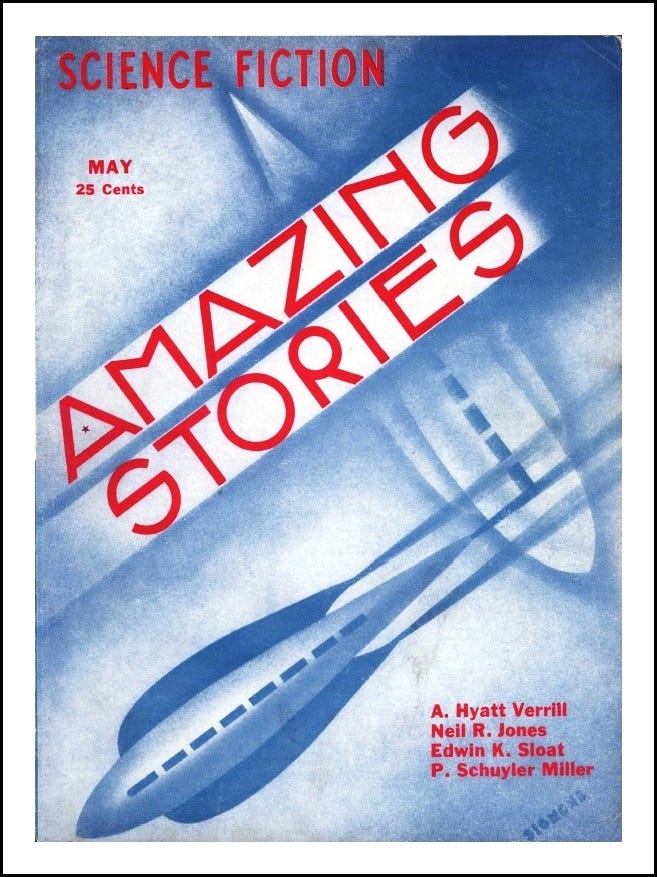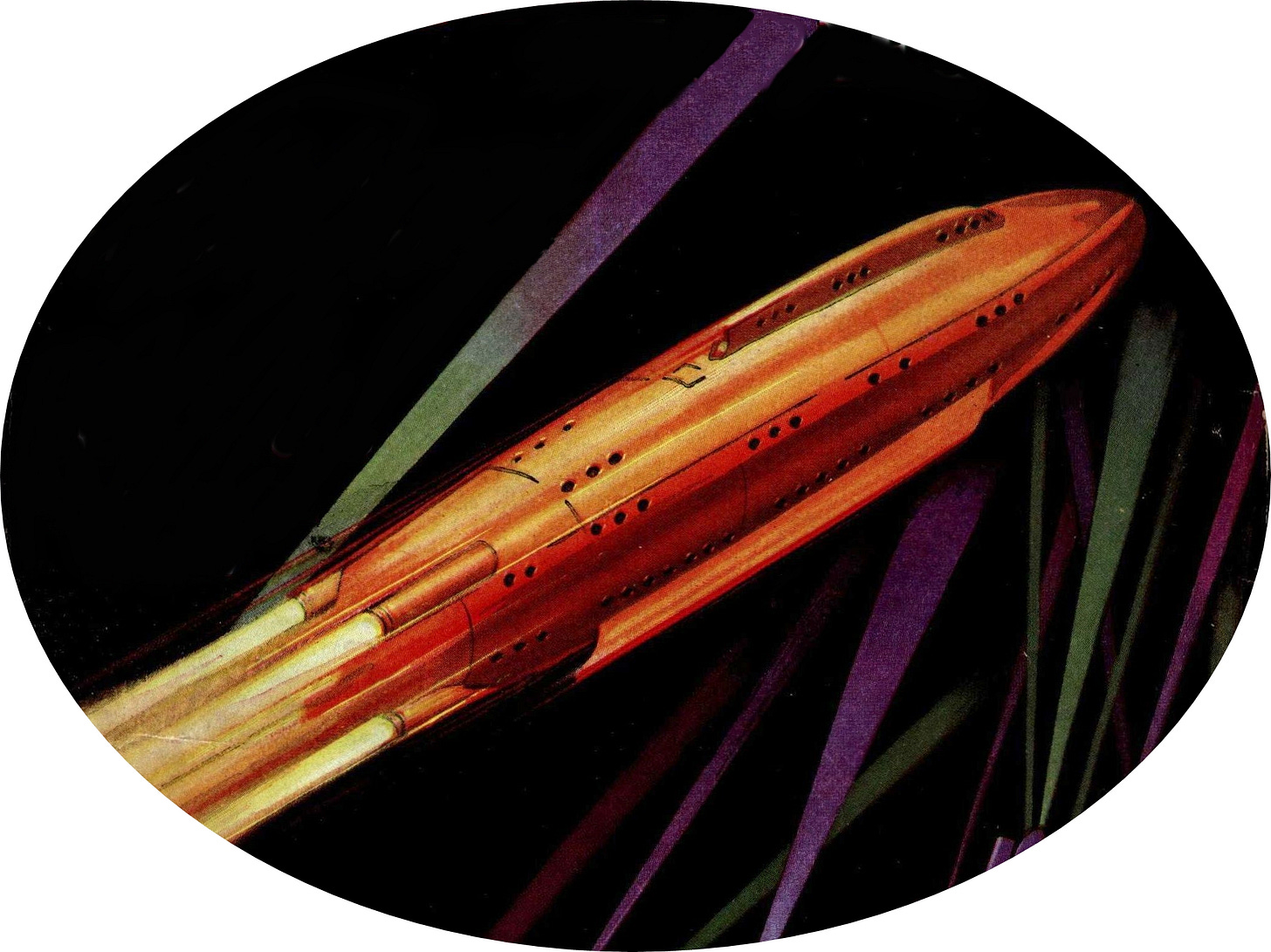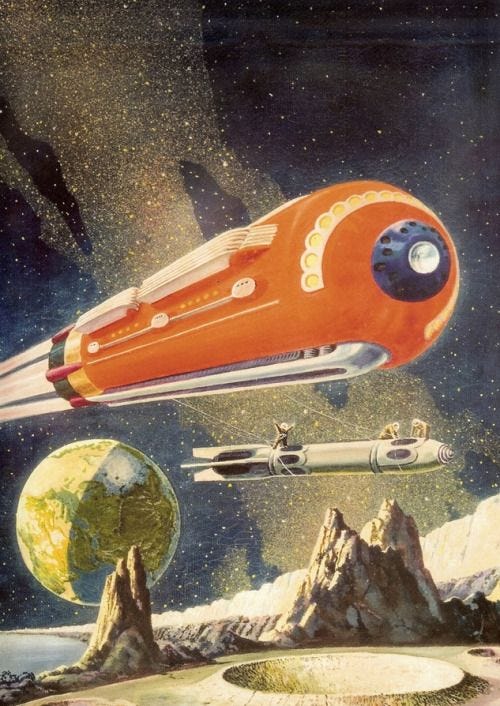This week I’m going to introduce you to my favorite space ship of all time—the Yodverl. It’s unlikely you’ve ever heard of it, it was only ever described in a pulp magazine in 1931. There is no illustration of the entire ship, just a partial interior. And I, myself, have not illustrated it…yet. The illustrations in this post are all from the 1920’s and 1930’s and illustrate the type of ship we’re talking about here.
I could give you a simple summary but I’m not going to do that. Instead, I’m going to let the writer speak for herself. The following is quoted from “Across the Void,” by Leslie F. Stone, only ever published in AMAZING STORIES in the April 1931 issue. The quote is taken from pages 15-17. This tale is a direct sequel to the popular, “Out of the Void,” published in AMAZING, two years previously, in 1929.
Such a ship, designed by a woman, with a woman’s idea of what a space ship might be, intrigues me. You must ignore some of the period science, especially the uses of Radium, which we know today is toxic. But the ideas of its uses are interesting and perhaps modern science could contrive something safely but of similar effect.
The description is somewhat on the long side so I won’t blame you if you don’t want to read all of it. But in case you do, I hope it sets your imagination afire, as it does mine. Happy reading!
“The following day Moura-weit's mighty Ship of the Void, the Yodverl, was brought out of hiding and was docked upon the great airport atop the World Air Lines Building….Pictures are preserved for us today; and there are the accounts to be found in history books, but for fear that some detail has been forgotten we shall outline its features here. One thousand feet in length the Yodverl was, cigar shaped and snowy white, constructed of forty layers of that serviceable Abruian glass the shell was stronger and more rigid than the diamond. It had that unique quality, whereby those outside could not see within, but those in the ship at various vantage points could see outside as clearly as through ordinary plate-glass.
“At each of the conical ends of the cigar were set the great disks of the meteorite deflectors, machines that meant so much to the safety of the ship in Space. Under the port at the stern of the ship was set its airlock by which voyagers could leave the flyer without affecting the atmosphere within the ship when on an alien untried planet, but the main entrance lay in one side of the machine, about fifty feet from the Yodverl' s nose. This doorway was circular, and fitted so carefully as to not be seen from the outside when closed, but opened upon invisible and intricate hinges revealing a corridor twenty-feet long, into which the door itself fitted perfectly when not in use. The anteroom that this door revealed was also the study and library of the flyer, containing thousands of Abruian and earthly books for the traveler as well as the ship's log. Three doorways opened from this chamber, the first leading into the pilot room that took up the entire forepart of the ship being set directly in its nose. Here were the controls that directed the flyer through space, although the motors were located far aft. And here one had a clear, unobstructed view of the heavens above, and out in space, on either side and below.
“On the floor forward, or rather in the curvature caused by the nose of the ship, was set a great stellar map that was highly interesting to the astronomer showing the solar system in miniature and a small area of the Universe round about in proper proportion as to size and distance. To one side of the controls was an odd arrangement of small round globes set in a circular tank filled with a heavy liquid. Again these represented the solar system, Sol, and the system of the ten planets known to Abrui with their satellites and a number of the largest asteroids. Intricate machineries controlled the movements of the globes, which showed at all times the exact position of each planet in its relation to their star even to the slightest deviation caused by the action of each planet upon another. This mechanism was invaluable to the interplanetary pilot, as were dozens of other instruments in the room, that would have been interesting only to the astronomer; chronometers that told solar and sidereal time on various worlds, instruments that felt out the dangers of space, instruments of all sorts and descriptions without which space-navigation would have been virtually impossible. Practically all the instruments to be seen were the inventions of Moura-weit who had willed to his people all his effects. And on studying his achievements, one has to concede that he was possibly one of the greatest men of all times.
“The second door of the ante-room opened into the laboratory where one was to find more intricate and delicate instruments for various uses. Here was the Venerian [Venusian] telescope whose complicated lenses made it available for use within the twenty foot deep shell of the Yodverl, and there were more intricate and delicate instruments for various uses. Here the scientist had developed most of his works, his gravity nullifier, his meteorite repeller, the ship's own gravitational field. Here he had accomplished the last steps of developing solids from the ether stream, and here were to be found three uncompleted machines that the inventor had not finished at the time of his death. One of these appeared to be a super-radio set, but was in truth the beginnings of the machine that is so useful to us of today, the SolidTransformer, that sends solids from one locality to another by translating them into their atomic vibrations and reassembling them again into their specific forms at their destination. Luckily Moura-weit had left his notes so that his son Ezra could succeed in completing it for the use of the two worlds of Abrui and Earth.
“The third door leading from the anteroom opened to the living quarters of the ship. In fitting out his vessel, Moura-weit had copied the appointments of his own home as exactly as he could, so on entering, one found himself immediately within the confines of a typical Abruian home. The first chamber, the atol, was identical with the living room of the Earth home, for here the family gathered when the day's work and fun was over. But the Abruian atol serves more purposes than the drawing room of our homes. It was also the recreation room, as well as the dining room, resembling the ancient Roman atrium in some respects. The room was thirty feet wide and forty long, and in its center was a small swimming pool in the middle of which a tiny fountain played. Potted flowers of Abrui grew around its edge and on the mosaic tile floor were arranged wide comfortable couches, and a number of Abruian metal three-legged chairs, far more comfortable than our own. The walls of the room were ten feet in height and were also tiled, depicting a typical Abruian landscape scene with a city on one hill and the two suns, Sol and Tradr, and the satellite, in the midday sky.
“The ceiling of the chamber was the clear white glass of Abrui, the inner skin of the ship's shell. And here we come across the strangest features of all of Abrui. Fire to them is of little use because of their great deposits of radium and radium also supplants electricity, Radium alone spells power upon Abrui. Thus by treating the glass roofs of their homes with a radium solution, the Abruians force their sun to do double duty for them. The radioactive quality of radium is such that during the day the sunlight is absorbed by it, and at night becoming fluorescent it gives off the light thus received when the sun sets, just as phosphorus gives off light when darkness sets in. By imbedding tiny invisible wires through the glass, it is possible to switch off this light when required by arresting the action of the radium particles. So in the case of the Yodverl, its entire one thousand foot length with it twenty-foot shell, was in truth a great storage battery absorbing heat and light when in the sun's glare, dispensing it with the coming of darkness.
“The second room beyond the atol was called the dof, and was the inner private room of the family. The dof like the atol had tiled walls picturing a more intimate scene in a garden with the life-like figures of men, women and children in their leisure moments. Flowers grew about the walls so that they appeared to blend into the picture itself, or rather it made the observer feel as though the painted figures would soon turn to speak to him.
“Beside the two entrance doors at either end of the chamber, one from the anteroom, the other opening to a long corridor beyond, there were also six doorways on either side of the room, three on either side. These gave access to the sleeping chambers. Four of these rooms were of small size, plainly, though neatly furnished, with a wide sleeping couch, a chair, a chest of drawers and a full length mirror. The walls were of creamy tile, but it was the fifth room that proved most interesting. Here two of the smaller rooms had been sacrificed to the larger one, which was furnished in a wonderful fashion, as though for a queen. One who knew the story of the two lovers, understood immediately that Moura-weit, with loving hands, had fashioned that room for his wife Elsie Rollins. when she followed him into the Void.
“From the dof a wide corridor ran for fifteen feet or so with doors lining the walls. The first two doors, one on either side of the hall, proved to be bathrooms with everything installed for the comfort of the traveler, but the remainder of the doors were the entrances to large storerooms, a small placard on each door naming the articles contained therein in Abruian writing. At the end of the corridor a doorway opened into the ship's galley and kitchen. Here again had been a surprise for the first earthlings who saw it, for in truth the kitchen was a revelation. Had the Abruians nothing more to offer than their unique cooking and refrigerating units they would have found a ready market on Earth, as indeed they did. No longer need the housewife of our planet cry out against the drudgery of the kitchen as of yore, she need only to drop the food in the neat radium-treated glass dish, and minute s thereafter see each individual portion cooked to a turn!
“Yet one can imagine the wonder of the first to enter here to see the unkitchen-like appearance of the ship's galley with nothing more than the plain, clean walls of a room no more than eight feet square in view, but which the twist of a little switch on one wall revealed in all its mechanical wonder. Its walls disappeared as if by magic with row after row of shelves appearing instead, on which were arranged dishes of all shapes and designs, all of glass, all snowy white. To one side stood the refrigerator, enclosed entirely in glass holding fruits and vegetables that had made the trip from Abrui as fresh as the day they had been picked, and yet without revealing any machinery, nothing to keep the viands in their excellent state of preservation. Again it was the radium that gave a "cold-control" as well as the heating devices. Frozen drinks, ice-cream, all could be produced as easily as the cookery was performed. Only the insides of the dishes were so treated as we know so that one could hold within the hand the dish as it cooked a toothsome dinner.
“Beyond the kitchen of the Yodverl lay the small stable in which were housed the small herd of muti, Abruian cows, resembling somewhat our deer, that were always carried by the space-travelers to provide them with fresh milk, since no amount of refrigeration will keep the liquid fresh and its vitamins intact. To the Abruian, milk is as necessary to his diet as bread is to the Earthman. At the present time the Yodverl was carrying eleven of the pretty deer-like creatures. The bull of this particular herd was the descendent of the first mitu to have been born on Moura-weit's first journey to Earth twenty years before.
“Muti have never grown familiar to Earth since we have sufficient bovines of our own breeding to meet our demands, and besides the Earthmen have never felt the need of having to introduce the talking beasts of Abrui to our world. As one knows, the Abruians had long since discovered the language of their domesticated cow as they have of most their beasts and therefore are able to converse with them to a small extent. However, as the mentality of the beasts is of a low degree, the language is very simple and very little informative.
“Beyond the stable which was kept as neatly as the rest of the ship, another corridor continued on through more storerooms to the air-lock and into the motor-room, where the small radium motors were locked away.”
Fun, eh?
This is the Rocketeer signing off for today.










Buster Crabbe on board?...
My favorite is the Outlaw Star, hands down. For MANY reasons.
But I prefer the mer-ka-ba, personally. Simple and without machine fuss.
😉😉
🚀 to infinity and beyond!
Outlaw Star! I haven't watched that one although it reminds me of "Cowboy Bebop." Good times!
Yes, indeed, the Mer-Ka-Ba is the best in many ways. :) I once read a channeled account of a gal's other incarnations going through a process of ascension. Despite her becoming less physical, she still enjoyed brushing her hair, even though she didn't need to. I think that, even if I had full access to my Mer-Ka-Ba to travel, I'd still like to try out one of those funky old starships that look like the Chrysler Building set on its side. With or without Buster Crabbe on board. LOL ;-)